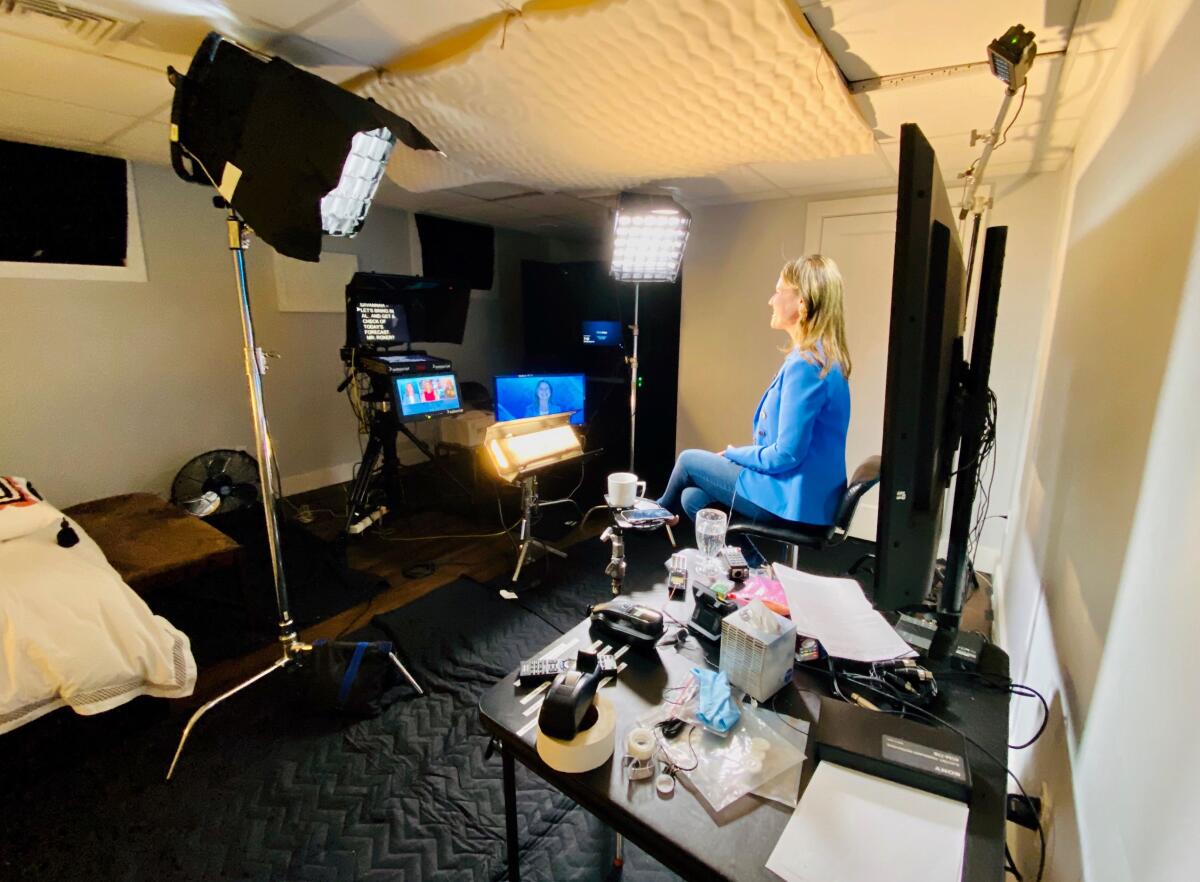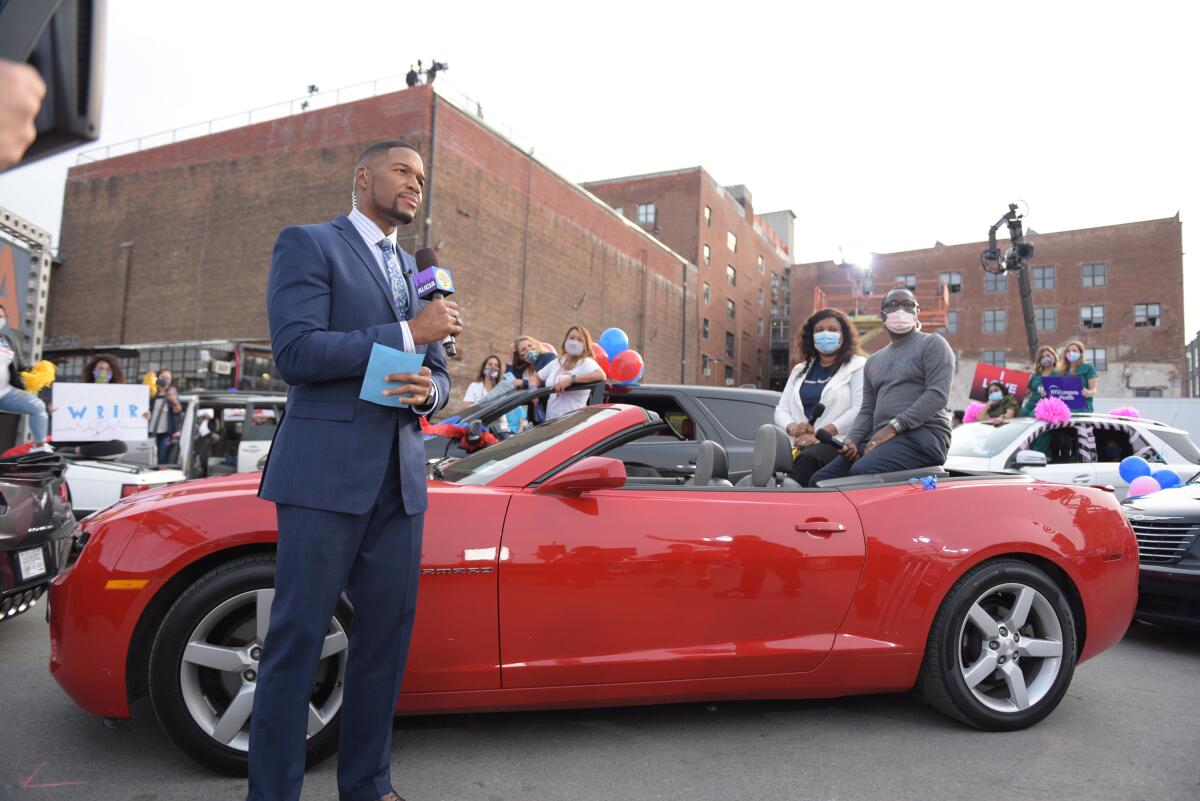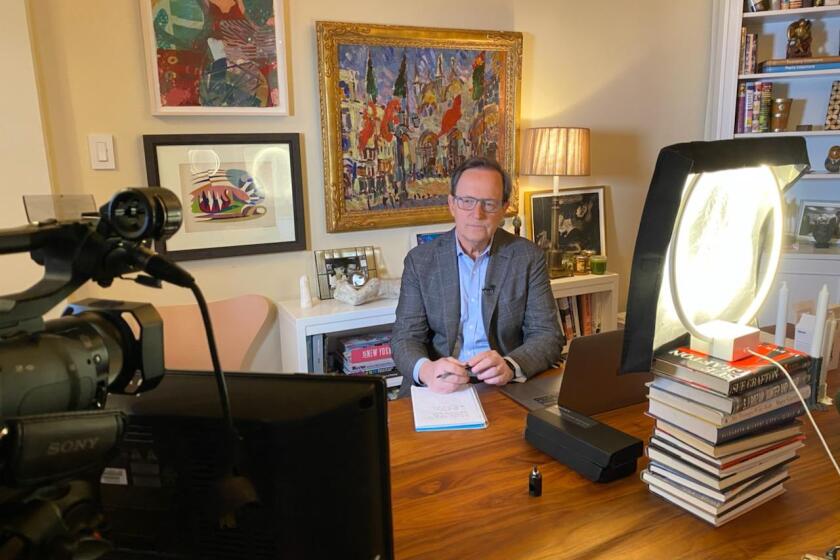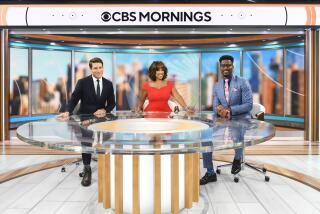How the pandemic has forever changed TV news
- Share via
One year ago, “Today” co-anchor Savannah Guthrie was told by her bosses that growing concern over the COVID-19 pandemic could mean big changes for the NBC morning program.
“They said, ‘Listen, the network wants to install a studio in your home just in case,’” Guthrie recalled in a recent interview. “I thought it was hilarious. I just thought that was never going to happen.”
But it did happen. Guthrie soon found herself in the basement of her upstate New York home doing live early-morning interviews with top government officials and business leaders as the national health emergency escalated. “And I could hear my kids riding their scooters right above me,” she said.
Guthrie, whose special “COVID One Year Later: Life After Lockdown” (co-anchored with Lester Holt) airs Thursday on NBC and streams on Peacock, was not alone. Unlike scripted TV shows and movies that shut down and delayed production, network and local news programs needed to stay on the air and adapt to safety protocols. Anchors, correspondents and meteorologists across the country delivered reports from makeshift studio setups, at times while children occasionally interrupted and pets wandered by.

As more of the population gets vaccinated and social-distancing restrictions are relaxed, many anchors have headed back to their familiar sets, where social distance is maintained. But the innovations and efficiencies discovered by the TV news business over the past year are likely to last when the pandemic is hopefully a distant memory.
“I think the days of sending a full camera crew to grab what will ultimately be a 12-second sound bite for a ‘Nightly News’ piece are over,” said NBC News President Noah Oppenheim. “In many ways, it’s actually opened up what we can do because it means a lot of the logistics getting cameras to places or people to studios are no longer obstacles to conversations we want to have.”
While more consumers confined to their homes increased their dependence on streaming video for scripted TV shows and movies, TV news viewing grew by 30% over the past year, according to Nielsen data, thanks in large part to interest in the 2020 presidential election and coverage of the pandemic. The data showed viewers are willing to accept a presentation that may be less slick than usual if they are getting the information they need.
“We’ve learned that the audience is mostly interested in the substance, and so if you can get that expert and that newsmaker but you can only get him or her on Zoom in their living room, that’s fine and the audience will embrace that,” Oppenheim said.
Ken Jautz, executive vice president for CNN, said audiences likely empathized with what news operations have gone through.
“People in all walks of life were trying to figure out how to go about their businesses with great and unprecedented limitations,” Jautz said. “And our business was no different, and I think people understood that and are very flexible.”
D’Artagnan Bebel, senior vice president and general manager at KRIV, the Fox-owned TV station in Houston, said his correspondents have found it easier to book interviews for their pieces by using Zoom instead of sending a crew to travel to a location and set up and then break down equipment, which can take more than hour.
“A lot more people are saying yes,” Bebel said. “They pop on, they do it and it’s less time on their part. It give us the ability to create more content.”
Remote broadcasting setups have become the new normal for TV anchors during the coronavirus crisis.
Jautz said CNN had 2,500 guests across its channels in the month of February, all from remote locations. He does not see that changing once the health crisis subsides.
“We will do far more of them remotely going forward than we did before the pandemic,” he said.
Wendy Fisher, senior vice president of newsgathering at ABC News, said her network always had a high priority on having guests in the studio, and will be eager to get back to it when conditions allow. But the pandemic also offered some lessons in what was possible in a pinch.
“We not only want to deliver news but it’s a visual medium and we want to make great TV,” Fisher said. “What we learned is flexibility sometimes is good. You can do things that you might not do if you didn’t have to, and it would be fine.”
Guthrie said “Today” will maintain its high production standards, but the technological possibilities the pandemic introduced will give the program more options going forward.
“In breaking news, if somebody wants to get on the phone, if somebody wants to do it by Skype or on their cellphone, you know, we now know we can do it and we should do it, and everything’s not lost if it isn’t perfect broadcast quality,” Guthrie said. “We’ve all kind of had to be creative and resourceful.”
The World Health Organization announced the coronavirus outbreak had become a pandemic on March 11, 2020. Since then, the virus has seemingly touched all aspects of life in Southern California and beyond. The Times looks back on a full year of life in a pandemic.
Fox News outfitted trucks with fully operational studios that rolled up outside of some on-air hosts’ homes so they could step in and be on the air. Makeup artists sidelined from working at the network’s headquarters gave tutorials over Zoom so that anchors could touch up themselves.
CNN has what it calls “flash studios” that in the past were used primarily for guests; these use a remotely operated camera and require no technicians on site. “We adapted those flash studios to have the anchors use them,” Jautz said. “We’ve got it set up so that an anchor, he or she, does not interact with any single person.”
At the ABC News program “20/20,” interview subjects had mirrorless Sony cameras sent to their homes. The cameras were attached to laptops and producers controlled the shots remotely during tapings. The network’s “Good Morning America” show held one of its summer concerts as if it were a drive-in theater, with audience members watching Alicia Keys perform from their cars.
Panel discussion shows with multiple hosts and guests had to adjust as well, often resembling the iconic onscreen credits of the 1970s sitcom “The Brady Bunch.” It can be a challenge to deliver the kind of feisty on-screen interactions that are a signature of such shows.
“You can’t roll your eyes in a box on an eight-second delay,” said Harris Faulkner, cohost of Fox News daytime program “Outnumbered.”
Keeping household distractions away can be a challenge as well. One of Faulkner’s daughters gave her a unicorn headband as a way to wish her mother good luck. She decided to retrieve it in the middle of the program. “I said, ‘You know we’re on the air here,’” Faulkner recalled.
For some viewers the charm of at-home broadcasting is wearing thin. In Texas, where the governor lifted social-distancing restrictions and mandatory mask-wearing, not being at work is seen as a political statement. Bebel said viewers of KRIV have let the station know where they stand.
“Texas is a very polarizing state,” Bebel said. “Some people are like, ‘Get the hell back in the studio.’ Others say, ‘No, we understand.’”

Studio space is often the deciding factor of who comes in and who still works from home. On “Good Morning America,” the three lead anchors — George Stephanopoulos, Robin Roberts and Michael Strahan — are back in the program’s Times Square studio in Manhattan. But meteorologist Ginger Zee and regular contributor Lara Spencer continue to work remotely.
“We still have a restriction on the number of people in a studio at one time,” Fisher said. “Each talent is not just one person. There are producers involved. All our decisions are based on our own safety guidelines and CDC guidelines. You look back to February 2020, you would not only see anchors in Times Square but eight correspondents would be in the studio. They are not back yet either.”
Even inside the studio, social distancing makes the intimate atmosphere of morning TV hard to maintain.
“When Hoda Kotb and I look at that old footage we laugh and we say, ‘My goodness, we were practically sitting on each other’s laps,’” Guthrie said. “But we want to get right back there to that.”
More to Read
Inside the business of entertainment
The Wide Shot brings you news, analysis and insights on everything from streaming wars to production — and what it all means for the future.
You may occasionally receive promotional content from the Los Angeles Times.













